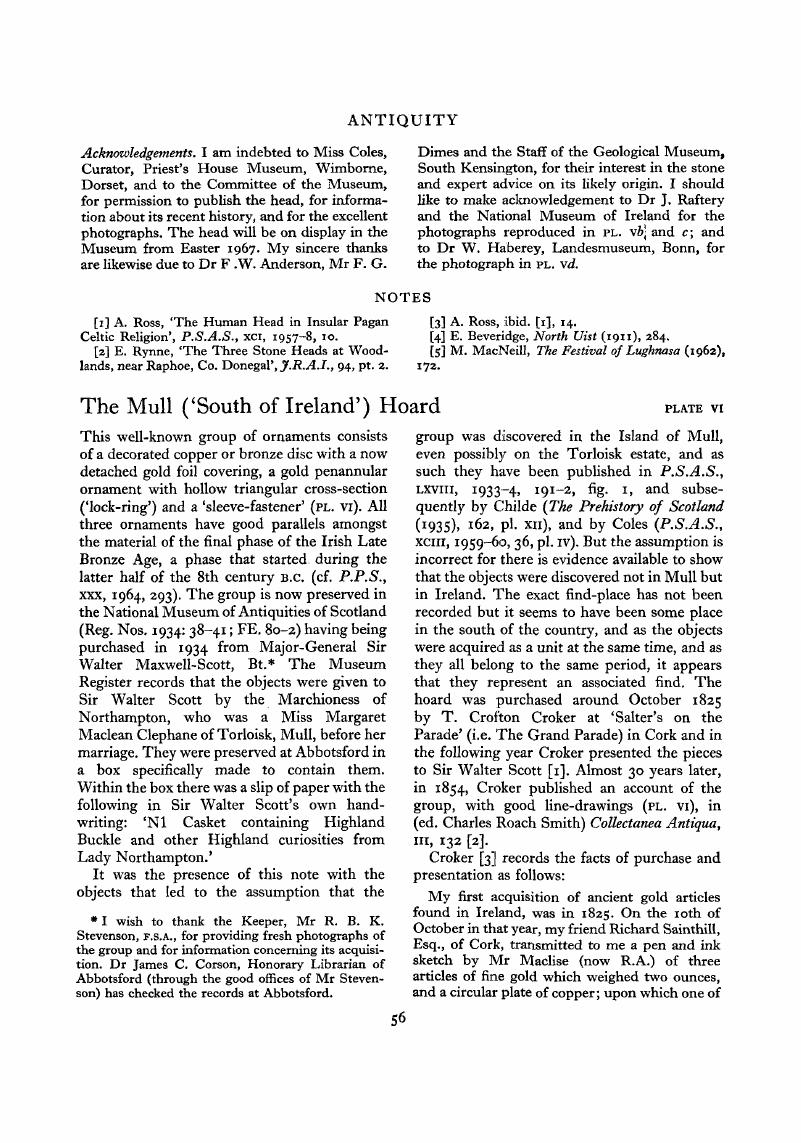No CrossRef data available.
Article contents
The Mull (‘South of Ireland’) Hoard
Published online by Cambridge University Press: 02 January 2015
Abstract

- Type
- Notes and News
- Information
- Copyright
- Copyright © Antiquity Publications Ltd. 1967
References
Notes
[1] This is recorded by Scott in his diary for 23rd October 1826: ‘Crofton Croker made me a present of a small box of curious Irish antiquities containing a gold fibula, etc. etc.’ Information from Dr Corson.
[2] Dr Michael Herity has pointed out to me that Croker’s account was republished by James Coleman, ‘Crofton Croker’s Gold Plates found in Co. Cork’, J.C.H.A.S., 1, 2nd series, 1895, 329. Dr Herity has also drawn my attention to a MS. in the National Library of Ireland which contains original drawings of some archaeological objects. In colour are the ‘lock ring’ and disc with its gold covering plate. Underneath is written ‘The size of the originals which were bought for me in Cork from a jewler named Salter in 1825 and by me given to Sir Walter Scott in 1827. T. Crofton Croker.’
[3] Thomas Crofton Croker was born in Buckingham Street, Cork, on 15th January 1798. He was an only son. His father (who was descended from a Devon family that received grants of land in the south of Ireland during the reign of Queen Elizabeth I) was an army major and his mother, Maria Dillon, was co-heir of Croker Dillon, Baltidaniel, Co. Cork. Croker received little formal education but at an early age he developed an interest in antiquarianism, literature and the arts, and between 1812–15 he travelled around the south of Ireland collecting songs and legends. Croker’s father died in 1818 and after that he left for England. He first went to visit Thomas Moore at his cottage in Wiltshire and then on to London where he secured a post of Clerk at the Admiralty. Soon Croker became a prolific writer. His Researches in the South of Ireland was published in 1824 while the following year The Fairy Legends and Traditions of the South of Ireland appeared. Croker was elected a member of a number of learned societies, among them the Society of Antiquaries of London, the Royal Irish Academy and the Royal Antiquarian Society of Copenhagen. He helped to found other societies, such as the British Archaeological Association in I 843. (Dictionary of National Biography ; Dublin University Magazine, 34, 1849, 202.)
[4] The meeting has been recorded by Sir Walter Scott in his Journal: ‘At breakfast, Crofton Croker, author of “Irish Fairy Tales”—little as a dwarf, keen-eyed as a hawk and of easy prepossessing manners—somethmg like Tom Moore. Here also Terry, Allan Cunningham, Newton and others’ (The Journal of Sir Walter Scott, vol. I. (Edinburgh, r8go), 278). This meeting between Croker and Scott seems to have been a sequel to the publication of the Fairy Legends. This work delighted Sir Walter and he wrote a complimentary letter V, Croker. This letter was printed in the second edition of vol. I. of the Fairy Legends and Croker dedicated vol. v to Scott ‘in admiration of his genius and in gratitude for his kindness’. Some correspondence between Scott and Croker has been published by Sir Herbert John Grierson in The Letters of Sir Walter Scott (London, 1g32–7), 1825: 94; 1826: 485, 509; 1827: 240.
[5] The object was still ‘collapsed’ when it reached the Museum but it was restored to its approximate original shape shortly after acquisition. There was a hollow specially made in the upper tray of the box to contain it.


